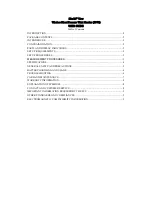
MANUAL BLOOD PRESSURE MONITOR BPM 168B
Contents
01....... Blood Pressure Monitor Intended Use
02....... 1. What is blood pressure ?
02....... 2. Why is it useful measure blood pressure
at home ?
.......... A. WHO blood pressure classifications
.......... B. Variations in blood pressure
04....... 3. Important information before use of
the unit
06....... 4. Device description
.......... A. Name of the parts
.......... B. Description of display symbols
08....... 5. Changing Batteries
08....... 6. Attaching pressure cuff
09....... 7. Correct measurement position
10....... 8. Description of display marks.
11....... 9. How to measure.
.......... A. Inserting batteries in position.
.......... B. Setting date and time.
12....... C. Steps to take blood pressure measurement.
13....... D. Storing recalling and erasing measurement
data.
13....... 10. Maintenance.
14....... 11. Safe- keeping.
14....... 12. To prevent malfunction.
15....... 13. Warning.
16....... 14. Specifications.
17....... Note
Blood Pressure Monitor Intended Use:
Measures human beings Systolic, Diastolic blood pressure and
heart rate using the oscillometric method. All values can be read
out in one LCD DISPLAY. Measurement position is on adult wrist
only.
Having one's blood pressure measured by a doctor in a hospital
tends to stimulate nervousness in the person and may even
create high blood pressure. Blood pressure in accordance with
variety of conditions varies. So judgment is not possible on the
basis of a single measurement.
It is better to take measurement at home. Regular home
monitoring will let you have a record of your measurements. This
information may provide a better reference of what your blood
pressure really is, and may help your doctor make important
decisions about your diagnosis and treatment.
If end-user has one of the diseases as heart troubles, Kidney
trouble or diabetes or Frustration problem of Blood vessel,
please consult a doctor before using the devices.
1.What is blood pressure ?
Blood pressure is a measurement of the force of blood flowing
against the walls of the arteries. Arterial blood pressure is
constantly changing during the course of the cardiac cycle. The
highest pressure in the cycle is called the systolic blood pressure,
the lowest is the diastolic blood pressure. Both pressure readings,
the systolic and the diastolic are necessary to enable a physician
























